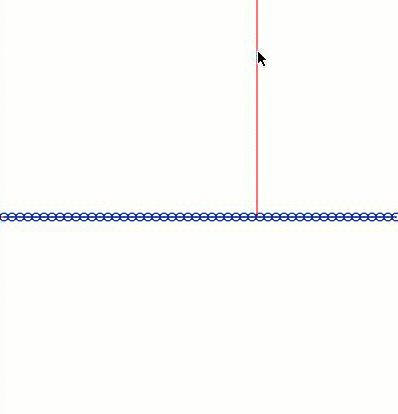Saya mencobanya.
Percikan (mata air)
Seperti yang disebutkan dalam tutorial itu , permukaan air seperti kawat: Jika Anda menarik beberapa titik kawat, titik di samping titik itu akan ditarik ke bawah juga. Semua poin juga ditarik kembali ke garis dasar.
Ini pada dasarnya banyak pegas vertikal di samping satu sama lain yang saling tarik juga.
Saya membuat sketsa di Lua menggunakan LÖVE dan mendapatkan ini:

Tampak masuk akal. Oh Hooke , kau jenius yang tampan.
Jika Anda ingin bermain dengannya, ini adalah port JavaScript milik Phil ! Kode saya ada di akhir jawaban ini.
Gelombang latar belakang (susun sinus)
Bagi saya, gelombang latar belakang alami seperti sekumpulan gelombang sinus (dengan berbagai amplitudo, fase, dan panjang gelombang) yang dijumlahkan bersama-sama. Inilah yang tampak ketika saya menulisnya:

Pola interferensi terlihat cukup masuk akal.
Semua bersama Sekarang
Jadi itu masalah yang cukup sederhana untuk menyatukan gelombang percikan dan gelombang latar belakang:

Ketika percikan terjadi, Anda dapat melihat lingkaran abu-abu kecil yang menunjukkan di mana gelombang latar asli akan berada.
Ini mirip sekali dengan video yang Anda tautkan , jadi saya akan menganggap ini sebagai percobaan yang sukses.
Inilah saya main.lua(satu-satunya file). Saya pikir itu cukup mudah dibaca.
-- Resolution of simulation
NUM_POINTS = 50
-- Width of simulation
WIDTH = 400
-- Spring constant for forces applied by adjacent points
SPRING_CONSTANT = 0.005
-- Sprint constant for force applied to baseline
SPRING_CONSTANT_BASELINE = 0.005
-- Vertical draw offset of simulation
Y_OFFSET = 300
-- Damping to apply to speed changes
DAMPING = 0.98
-- Number of iterations of point-influences-point to do on wave per step
-- (this makes the waves animate faster)
ITERATIONS = 5
-- Make points to go on the wave
function makeWavePoints(numPoints)
local t = {}
for n = 1,numPoints do
-- This represents a point on the wave
local newPoint = {
x = n / numPoints * WIDTH,
y = Y_OFFSET,
spd = {y=0}, -- speed with vertical component zero
mass = 1
}
t[n] = newPoint
end
return t
end
-- A phase difference to apply to each sine
offset = 0
NUM_BACKGROUND_WAVES = 7
BACKGROUND_WAVE_MAX_HEIGHT = 5
BACKGROUND_WAVE_COMPRESSION = 1/5
-- Amounts by which a particular sine is offset
sineOffsets = {}
-- Amounts by which a particular sine is amplified
sineAmplitudes = {}
-- Amounts by which a particular sine is stretched
sineStretches = {}
-- Amounts by which a particular sine's offset is multiplied
offsetStretches = {}
-- Set each sine's values to a reasonable random value
for i=1,NUM_BACKGROUND_WAVES do
table.insert(sineOffsets, -1 + 2*math.random())
table.insert(sineAmplitudes, math.random()*BACKGROUND_WAVE_MAX_HEIGHT)
table.insert(sineStretches, math.random()*BACKGROUND_WAVE_COMPRESSION)
table.insert(offsetStretches, math.random()*BACKGROUND_WAVE_COMPRESSION)
end
-- This function sums together the sines generated above,
-- given an input value x
function overlapSines(x)
local result = 0
for i=1,NUM_BACKGROUND_WAVES do
result = result
+ sineOffsets[i]
+ sineAmplitudes[i] * math.sin(
x * sineStretches[i] + offset * offsetStretches[i])
end
return result
end
wavePoints = makeWavePoints(NUM_POINTS)
-- Update the positions of each wave point
function updateWavePoints(points, dt)
for i=1,ITERATIONS do
for n,p in ipairs(points) do
-- force to apply to this point
local force = 0
-- forces caused by the point immediately to the left or the right
local forceFromLeft, forceFromRight
if n == 1 then -- wrap to left-to-right
local dy = points[# points].y - p.y
forceFromLeft = SPRING_CONSTANT * dy
else -- normally
local dy = points[n-1].y - p.y
forceFromLeft = SPRING_CONSTANT * dy
end
if n == # points then -- wrap to right-to-left
local dy = points[1].y - p.y
forceFromRight = SPRING_CONSTANT * dy
else -- normally
local dy = points[n+1].y - p.y
forceFromRight = SPRING_CONSTANT * dy
end
-- Also apply force toward the baseline
local dy = Y_OFFSET - p.y
forceToBaseline = SPRING_CONSTANT_BASELINE * dy
-- Sum up forces
force = force + forceFromLeft
force = force + forceFromRight
force = force + forceToBaseline
-- Calculate acceleration
local acceleration = force / p.mass
-- Apply acceleration (with damping)
p.spd.y = DAMPING * p.spd.y + acceleration
-- Apply speed
p.y = p.y + p.spd.y
end
end
end
-- Callback when updating
function love.update(dt)
if love.keyboard.isDown"k" then
offset = offset + 1
end
-- On click: Pick nearest point to mouse position
if love.mouse.isDown("l") then
local mouseX, mouseY = love.mouse.getPosition()
local closestPoint = nil
local closestDistance = nil
for _,p in ipairs(wavePoints) do
local distance = math.abs(mouseX-p.x)
if closestDistance == nil then
closestPoint = p
closestDistance = distance
else
if distance <= closestDistance then
closestPoint = p
closestDistance = distance
end
end
end
closestPoint.y = love.mouse.getY()
end
-- Update positions of points
updateWavePoints(wavePoints, dt)
end
local circle = love.graphics.circle
local line = love.graphics.line
local color = love.graphics.setColor
love.graphics.setBackgroundColor(0xff,0xff,0xff)
-- Callback for drawing
function love.draw(dt)
-- Draw baseline
color(0xff,0x33,0x33)
line(0, Y_OFFSET, WIDTH, Y_OFFSET)
-- Draw "drop line" from cursor
local mouseX, mouseY = love.mouse.getPosition()
line(mouseX, 0, mouseX, Y_OFFSET)
-- Draw click indicator
if love.mouse.isDown"l" then
love.graphics.circle("line", mouseX, mouseY, 20)
end
-- Draw overlap wave animation indicator
if love.keyboard.isDown "k" then
love.graphics.print("Overlap waves PLAY", 10, Y_OFFSET+50)
else
love.graphics.print("Overlap waves PAUSED", 10, Y_OFFSET+50)
end
-- Draw points and line
for n,p in ipairs(wavePoints) do
-- Draw little grey circles for overlap waves
color(0xaa,0xaa,0xbb)
circle("line", p.x, Y_OFFSET + overlapSines(p.x), 2)
-- Draw blue circles for final wave
color(0x00,0x33,0xbb)
circle("line", p.x, p.y + overlapSines(p.x), 4)
-- Draw lines between circles
if n == 1 then
else
local leftPoint = wavePoints[n-1]
line(leftPoint.x, leftPoint.y + overlapSines(leftPoint.x), p.x, p.y + overlapSines(p.x))
end
end
end



